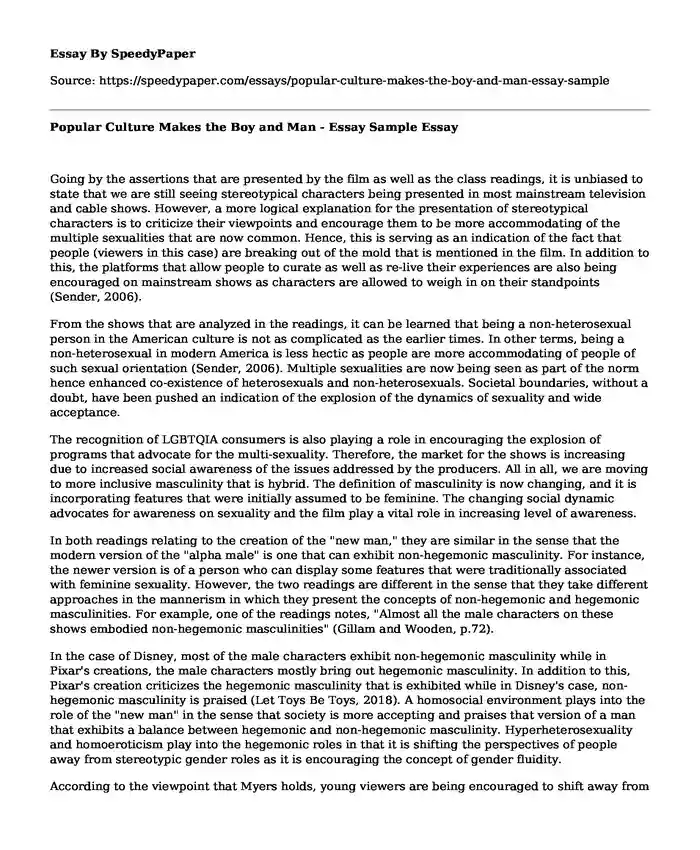Going by the assertions that are presented by the film as well as the class readings, it is unbiased to state that we are still seeing stereotypical characters being presented in most mainstream television and cable shows. However, a more logical explanation for the presentation of stereotypical characters is to criticize their viewpoints and encourage them to be more accommodating of the multiple sexualities that are now common. Hence, this is serving as an indication of the fact that people (viewers in this case) are breaking out of the mold that is mentioned in the film. In addition to this, the platforms that allow people to curate as well as re-live their experiences are also being encouraged on mainstream shows as characters are allowed to weigh in on their standpoints (Sender, 2006).
From the shows that are analyzed in the readings, it can be learned that being a non-heterosexual person in the American culture is not as complicated as the earlier times. In other terms, being a non-heterosexual in modern America is less hectic as people are more accommodating of people of such sexual orientation (Sender, 2006). Multiple sexualities are now being seen as part of the norm hence enhanced co-existence of heterosexuals and non-heterosexuals. Societal boundaries, without a doubt, have been pushed an indication of the explosion of the dynamics of sexuality and wide acceptance.
The recognition of LGBTQIA consumers is also playing a role in encouraging the explosion of programs that advocate for the multi-sexuality. Therefore, the market for the shows is increasing due to increased social awareness of the issues addressed by the producers. All in all, we are moving to more inclusive masculinity that is hybrid. The definition of masculinity is now changing, and it is incorporating features that were initially assumed to be feminine. The changing social dynamic advocates for awareness on sexuality and the film play a vital role in increasing level of awareness.
In both readings relating to the creation of the "new man," they are similar in the sense that the modern version of the "alpha male" is one that can exhibit non-hegemonic masculinity. For instance, the newer version is of a person who can display some features that were traditionally associated with feminine sexuality. However, the two readings are different in the sense that they take different approaches in the mannerism in which they present the concepts of non-hegemonic and hegemonic masculinities. For example, one of the readings notes, "Almost all the male characters on these shows embodied non-hegemonic masculinities" (Gillam and Wooden, p.72).
In the case of Disney, most of the male characters exhibit non-hegemonic masculinity while in Pixar's creations, the male characters mostly bring out hegemonic masculinity. In addition to this, Pixar's creation criticizes the hegemonic masculinity that is exhibited while in Disney's case, non-hegemonic masculinity is praised (Let Toys Be Toys, 2018). A homosocial environment plays into the role of the "new man" in the sense that society is more accepting and praises that version of a man that exhibits a balance between hegemonic and non-hegemonic masculinity. Hyperheterosexuality and homoeroticism play into the hegemonic roles in that it is shifting the perspectives of people away from stereotypic gender roles as it is encouraging the concept of gender fluidity.
According to the viewpoint that Myers holds, young viewers are being encouraged to shift away from non-hegemonic masculinities as they are more open to the dynamics of sexuality. Myers notes, "feminist television criticism argues that television has the potential to shift the gender order if it provides feminist messages and models for viewers" (Myers 70). One of her findings is that modern culture is being molded by mainstream media, which advocates for sexual inclusion. The messages being sent by television shows is that multiple sexualities need to be accepted and that people should be more welcoming of diversity regardless of the complications it might hold. Lopsided-masculine view of picture books is being ridiculed as it also supports stereotypic masculinity that is based on specific sexes. These articles fit together as they all tend to communicate one overarching message that the concept of multiple sexualities and needs to be absorbed into societal cultures.
References
Gillam, K., & Wooden, S. R. (2008). Post-princess models of gender: The new man in Disney/Pixar. Journal of popular film and television, 36(1), 2-8. https://doi.org/10.3200/JPFT.36.1.2-8
Let Toys Be Toys. (2018). Constructing bias - the wonky world of picture books. [online] Available at: http://lettoysbetoys.org.uk/constructing-bias-the-wonky-world-of-picture-books/ [Accessed 4 Jun. 2019].
Myers, K. (2012). "Cowboy up!": Non-Hegemonic Representations of Masculinity in Children's Television Programming. The Journal of Men's Studies, 20(2), 125-143. https://doi.org/10.3149/jms.2002.125
Sender, K. (2006). Film Screening of Further Off the Straight and Narrow: New Gay Visibility on Television by Katherine Sender | Annenberg School for Communication. [online] Asc.upenn.edu. Available at: https://www.asc.upenn.edu/news-events/news/film-screening-further-straight-and-narrow-new-gay-visibility-television-katherine [Accessed 4 Jun. 2019].
Cite this page
Popular Culture Makes the Boy and Man - Essay Sample. (2023, Jan 18). Retrieved from https://speedypaper.net/essays/popular-culture-makes-the-boy-and-man-essay-sample
Request Removal
If you are the original author of this essay and no longer wish to have it published on the SpeedyPaper website, please click below to request its removal:
- Literary Essay Sample: The Necklace Story Research
- Essay Sample on the Ways Ethical Dilemmas Can Influence the Student as a Leader
- Comparing the Cultural Perspectives of Kluckholn and Hofstede, Essay Sample for You
- Free Essay abot the Controversy of Robots in the Workplace
- Free Paper for You: Bipolar Disorder Research Article Review
- Essay Sample: Abstract, Semi-Abstract, Non-Objective Paintings
- Paper Sample - Postcolonial Thought Unveiled: Navigating Equity in a Modern World
Popular categories





